Featured Comment:
“This ramen recipe was so good! It was easy to make, too. The miso got it close to tasting like my favorite local restaurant ramen. I’ll definitely be making it this way from now on.”
– Misty
What is Miso Ramen?
Miso ramen (味噌ラーメン) is a popular Japanese noodle dish made with a broth flavored with miso paste. Originally from Hokkaido, “Sapporo Miso Ramen (札幌味噌ラーメン)” is the most famous version, but there are also many other regional variations.
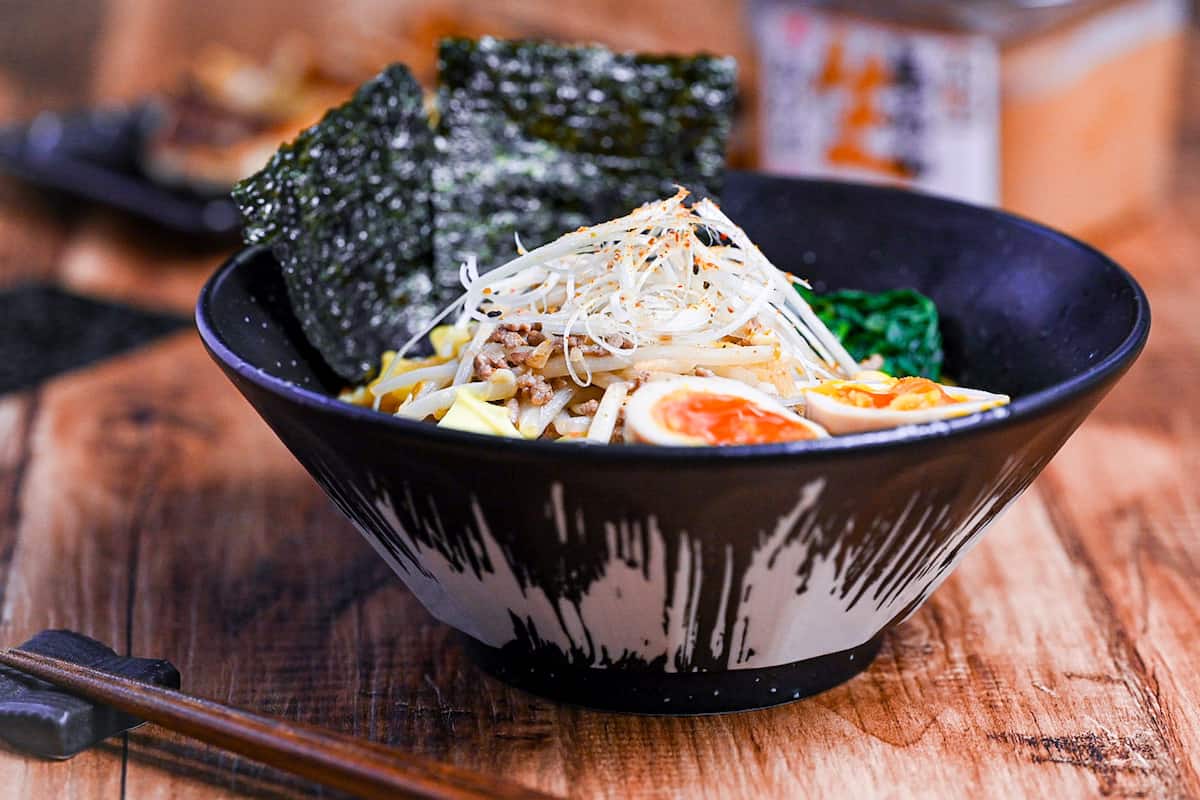
Sapporo ramen, which started in a restaurant called “Aji no Sanpei (味の三平)” in Hokkaido in 1955, is one of the most well-known miso ramen dishes in Japan. Although there are various theories about its origin, the owner was likely inspired by a regular customer’s request for ramen in tonjiru (pork miso soup).
Since then, it has become one of Japan’s most popular miso ramen dishes.

How I Developed This Recipe
Compared to shoyu ramen, shio ramen, and tonkotsu ramen, making miso ramen is easy to make at home as miso itself is an already umami-packed condiment. Therefore, I did nothing complicated in this recipe and prioritized reproducing the authentic taste as quickly as possible.
For example, I added my twist using seasoned ground pork instead of chashu pork and peanut butter to create a creamy texture.
It only takes 15 minutes to make, is easy to prepare, and tastes so good!
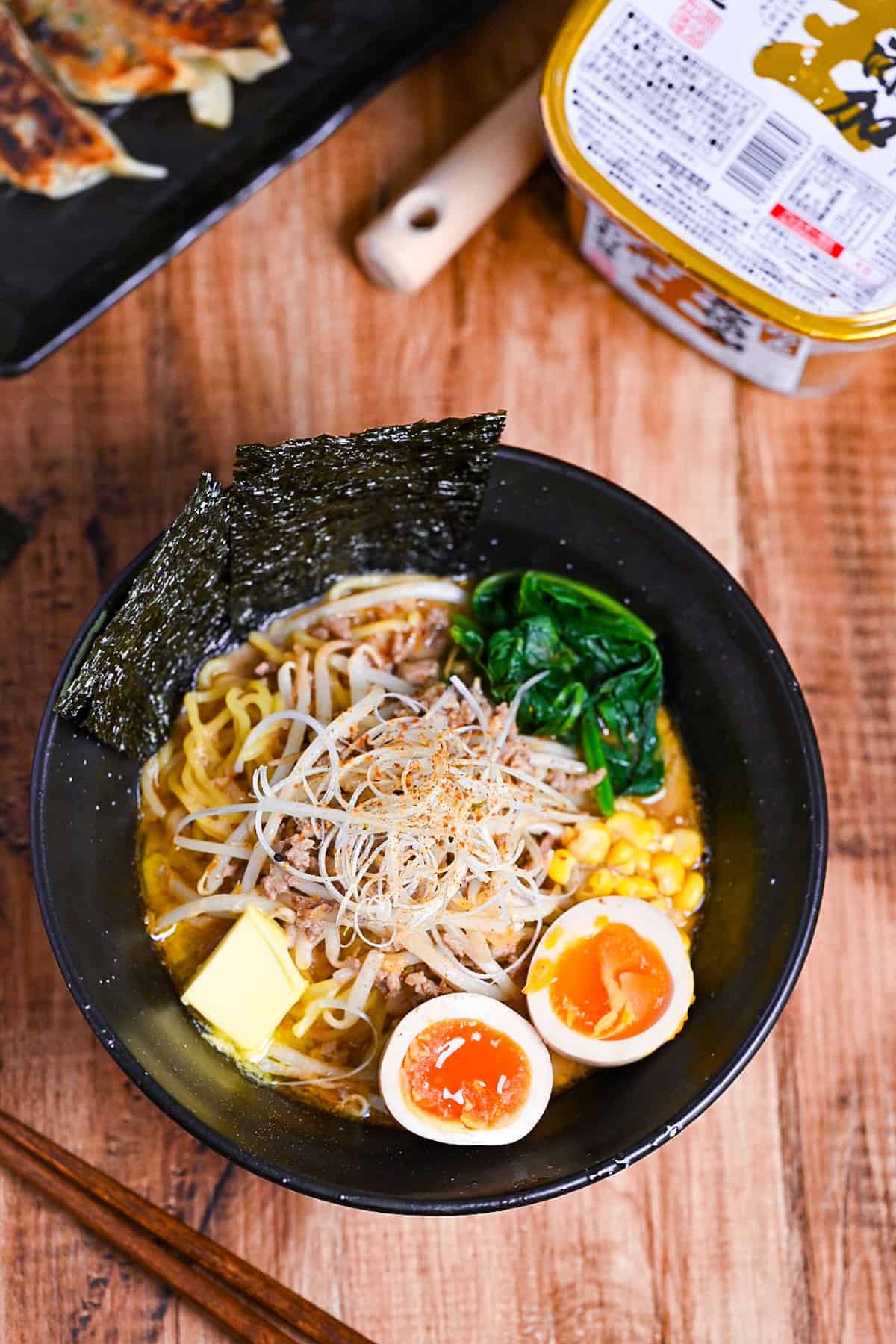
Ingredients & Substitution Ideas
- Unsalted butter: Go for high-quality unsalted butter to make sure you get the salt content in your dish just right. If you’d rather use salted butter, just remember to adjust other salty ingredients to keep the flavor balance just right.
- Ground pork: While ground pork is a great choice for a classic flavor, feel free to experiment with ground beef, chicken, or even a plant-based substitute.
- Garlic & Ginger: For the best flavor, use freshly minced garlic and grated ginger. If you’re short on time or find preparation challenging, high-quality store-bought garlic or ginger paste can be convenient alternatives.
- Japanese leek: For this recipe, focus on using the white part. Regular leeks or finely chopped yellow or white onions can work as a good substitute
- Soy sauce: Go for a Japanese dark soy sauce for the most authentic flavor. For a detailed look at different types of soy sauce, check out my “Guide to Soy Sauce.”
- Mirin: Try to find the real deal, “hon mirin” (本みりん), for its amazing depth and complexity of flavor.
- Oyster sauce: It add a delicious umami depth and a savory complexity to the dish.
- Chili bean sauce (Toban Djan): Adjust the quantity to your preferred level of heat.
- Chinese-style chicken bouillon powder: If you’re looking for a vegetarian or vegan option, feel free to substitute with your favorite plant-based bouillon or umami seasoning.
- Plain smooth peanut butter: It adds a rich, deep flavor to the soup base.
- Awase miso paste: This dish’s flavor profile is built on this one ingredient. Any miso paste will do the trick, but I highly recommend Awase (Yellow) Miso for its perfectly balanced flavor.
- Ramen noodles: For the best experience, why not try making your own fresh ramen noodles? It’s easier than you might think! For more details and other options, check out my article on making homemade ramen noodles. Just a heads-up: Avoid using the fried noodles from instant cup noodles.
- Toppings: I’d suggest blanched spinach, crisp bean sprouts, sweet corn kernels, chopped green onions, a pat of butter, perfectly cooked ajitama eggs (marinated soft-boiled eggs), and crisp nori seaweed. But feel free to mix and match these or add your own favorites to create your perfect bowl!
This recipe is easy to adapt for vegetarians. Simply swap the meat out for crumbled tofu or TVP (textured vegetable protein) and omit the oyster sauce. The chicken stock powder can be swapped for your go-to vegetarian alternative stock powder. If you want more plant-based topping ideas, check out my spicy vegetarian miso ramen recipe!
Curious about the exact brands and products that bring my recipes to life? Discover the brands and ingredients behind my recipes at the Sudachi Amazon Storefront. Explore my handpicked pantry essentials and find your next kitchen favorites!
Jump to Full Recipe Measurements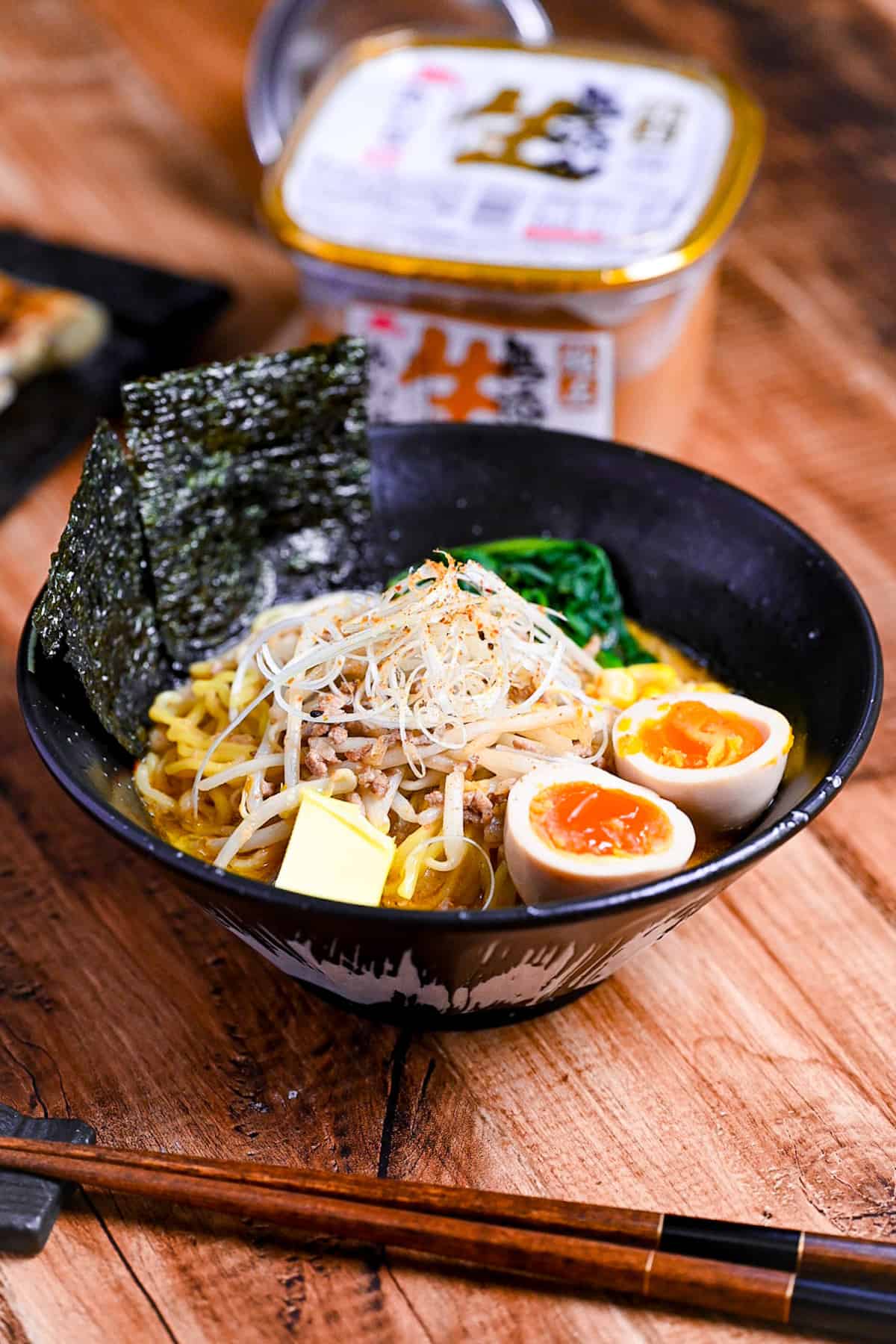
Visual Walkthrough & Tips
Here are my step-by-step instructions for how to make Miso Ramen at home. For ingredient quantities and simplified instructions, scroll down for the Printable Recipe Card below.
Start by heating a pan on medium and melting a small amount of butter to grease the surface. Add finely chopped garlic, ginger and green onions. Once fragrant, add the ground pork and stir fry until cooked through.
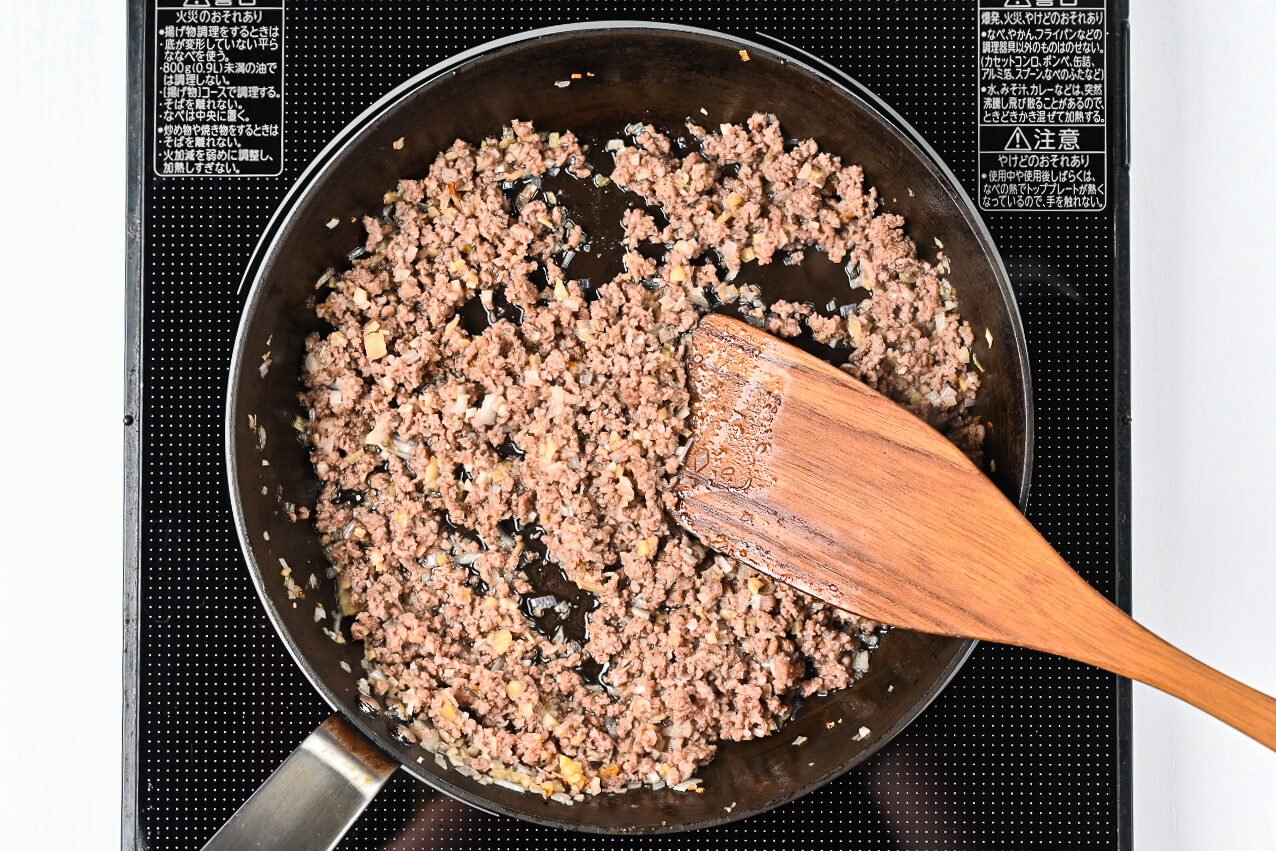
Add soy sauce, mirin, oyster sauce, and chili bean sauce. Mix thoroughly and cook until the liquid has almost gone, then turn off the heat.
While you wait for the condiments to reduce, bring a pot of water to a boil for the noodles, and boil water for making the broth.
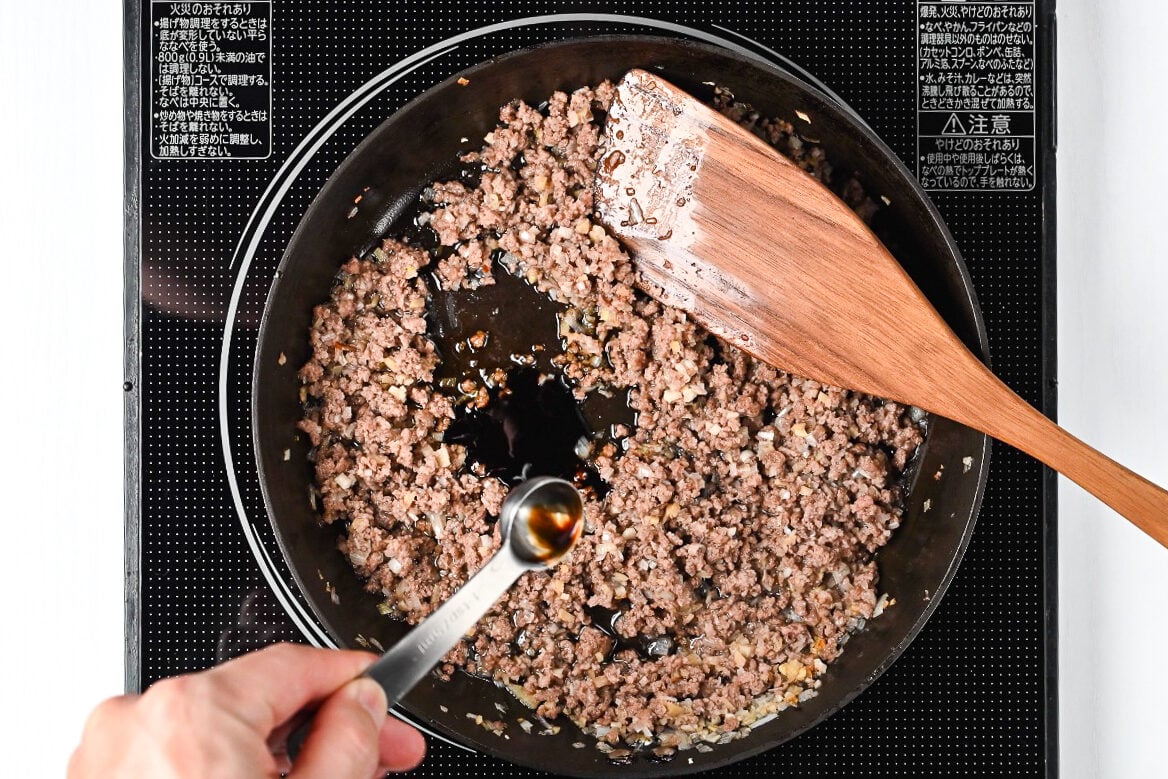
In a heatproof measuring jug, add freshly boiled water, chicken bouillon powder and smooth peanut butter. Whisk them together until dissolved and lump-free. Pour the broth into the pan and bring to a boil over a medium heat.
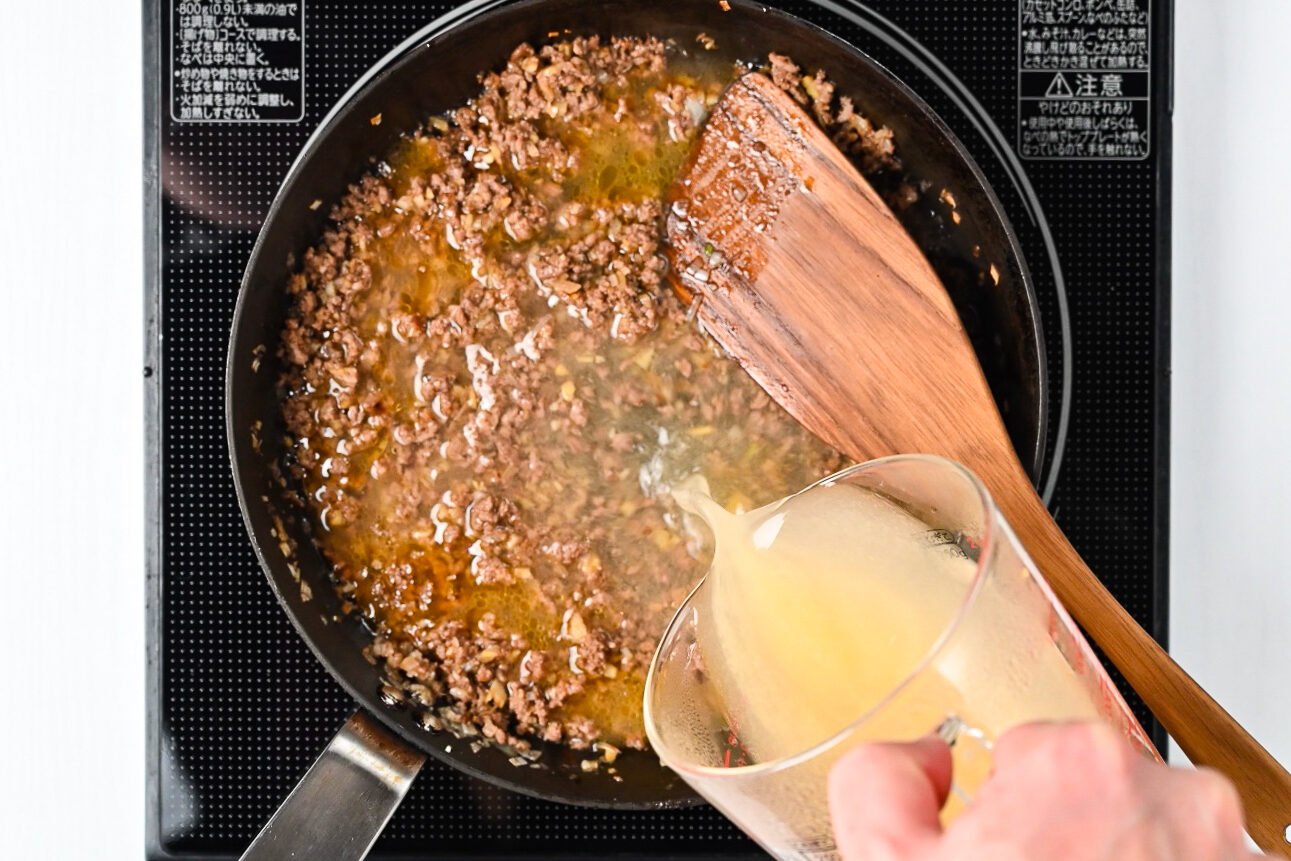
Once the broth starts to boil, turn off the heat and add the miso. Adding the miso paste after the heat is turned off will preserve its rich and unique taste.
To avoid lumps, place the miso on a mesh spoon or ladle and submerge it in the broth to soften it, then lift it out and whisk it on the spoon before allowing it to seep into the rest of the cooking liquid.
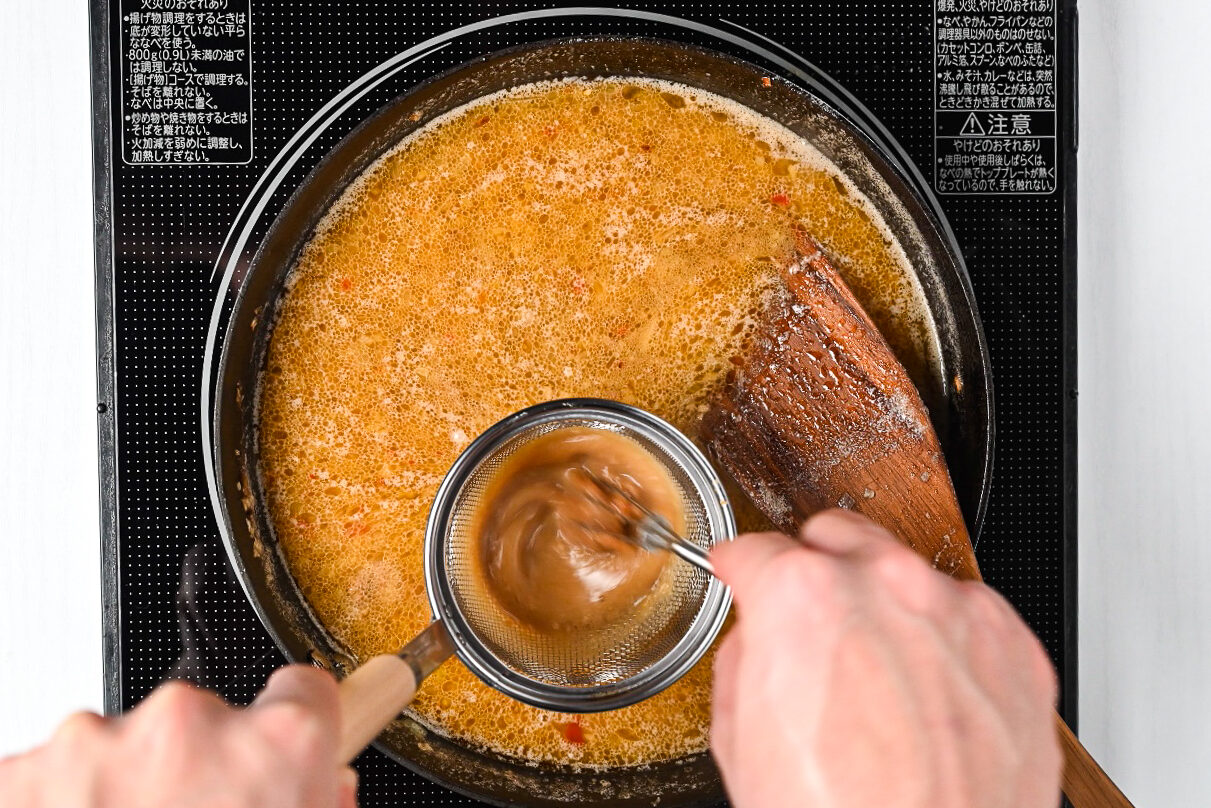
Tip: If you don’t have a mesh spoon or ladle, place the miso paste in a small bowl and add a small amount of broth. Whisk until smooth and then pour it back into the pan.

If using beansprouts, add them to the broth and leave them to cook in the residual heat for a few minutes while you cook the noodles. If you like your broth piping hot, feel free to reheat right before serving.
Cook the ramen noodles according to the instructions on the packaging. Make sure to use plenty of water to avoid them becoming too starchy.
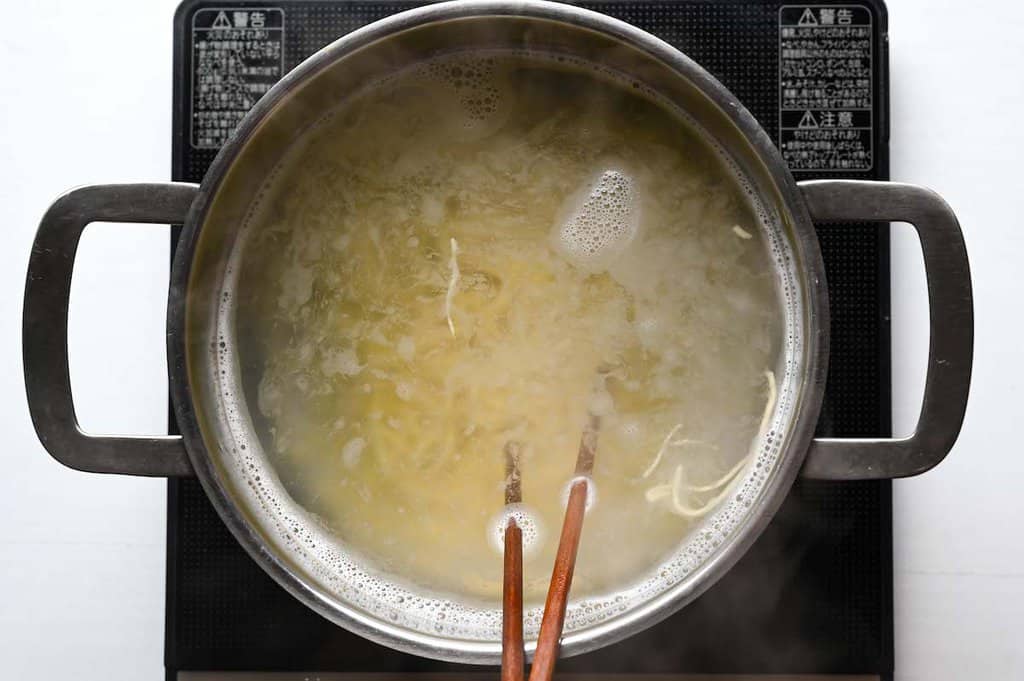
In the final minute, add spinach leaves.

Once cooked, drain with a colander and rinse with hot water to wash off any excess starch.
Divide the noodles between serving bowls.

Pour the broth and ground pork over the noodles and arrange the toppings.
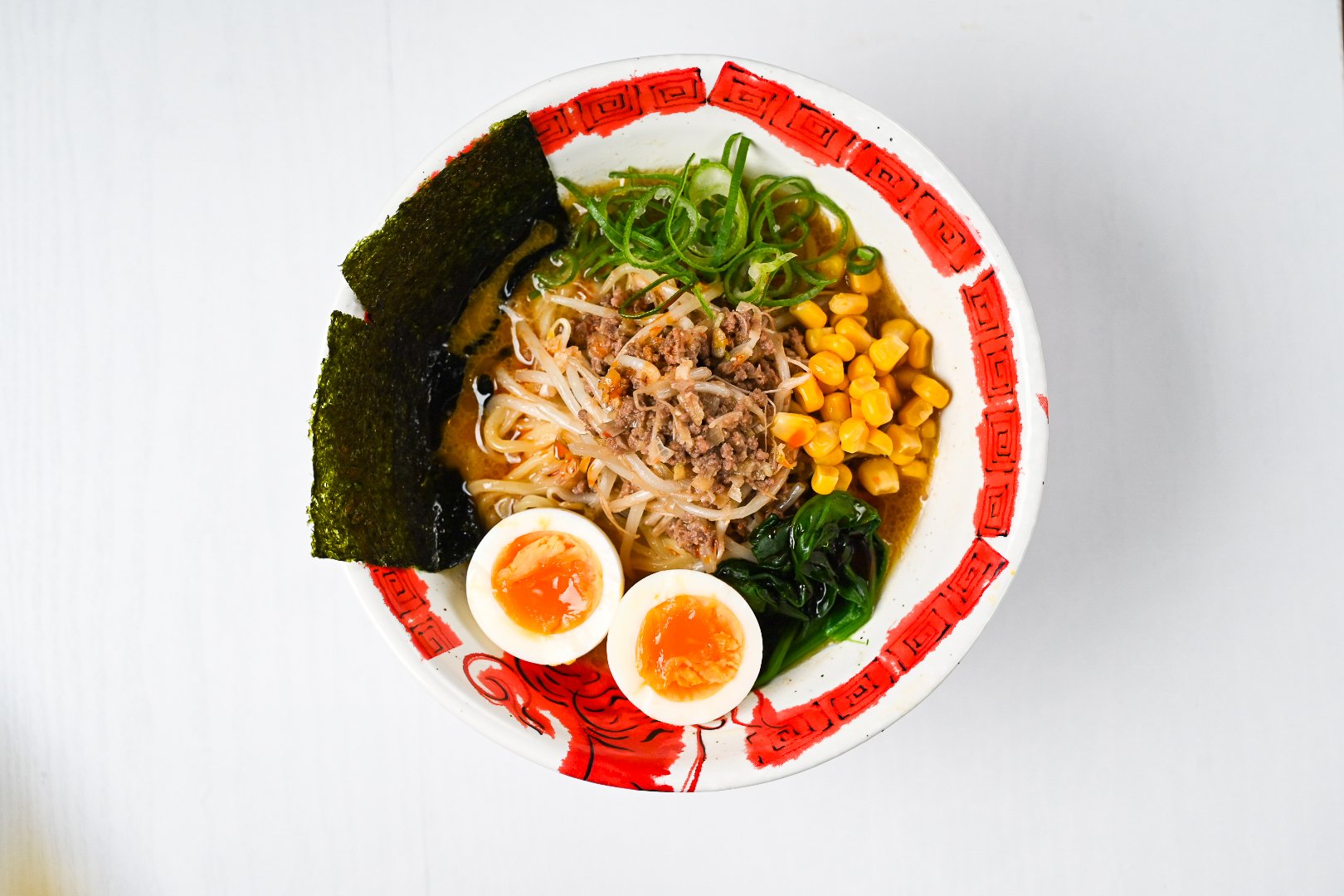
Enjoy!
Jump to Full Recipe MeasurementsTroubleshooting & FAQ
Miso is a savory paste crafted from fermented soybeans and comes in several varieties. While you can use miso paste for this recipe, I recommend starting with awase (yellow) miso.
Add the freshly-cooked noodles immediately to the soup for the best ramen experience, whether at a restaurant or home. Any amout of waiting can make the noodles mushy as they absorb the broth, diminishing the dish’s quality. Quick action is vital.
This issue often arises from boiling fresh ramen noodles in insufficient water. Use a large pot and plenty of water (just like you would do to cook pasta) to prevent excess starch from adhering.
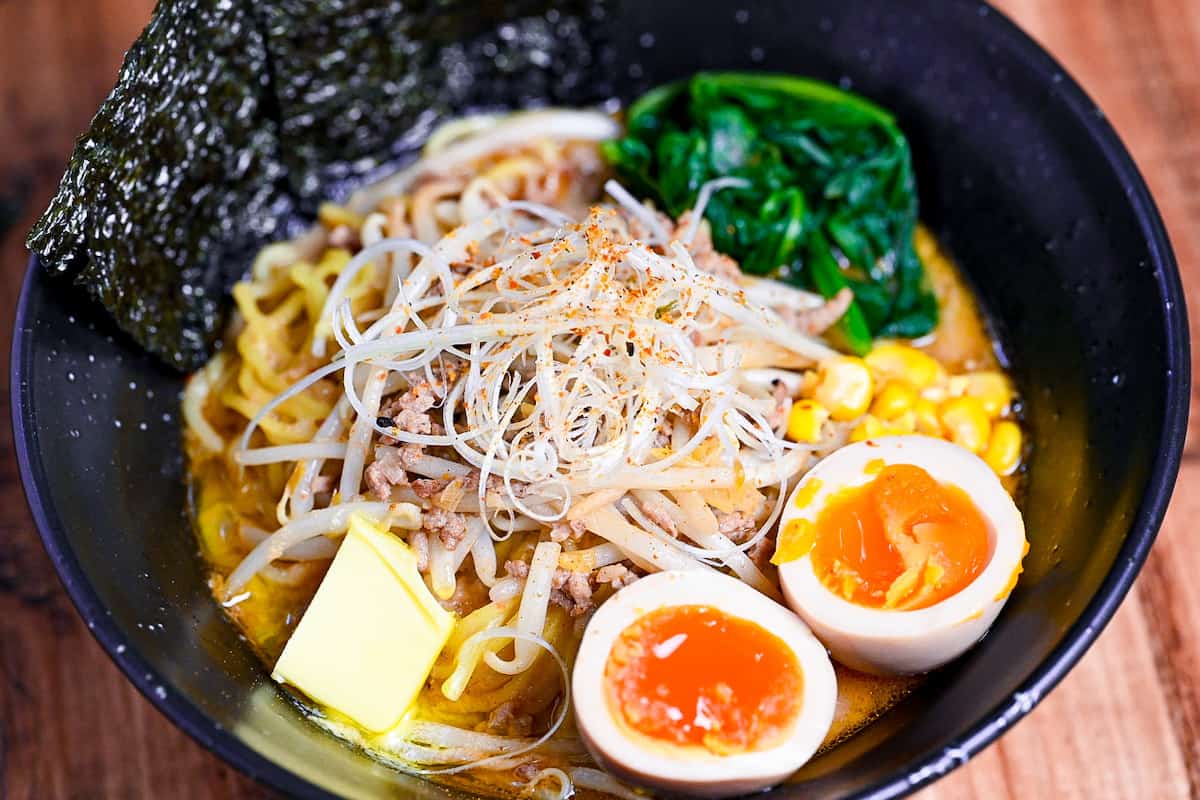
How to Store
Storing ramen isn’t typically recommended. However, if you must save leftovers, it’s advisable to keep only the broth and not the noodles.
Ideally, ramen should be consumed immediately after preparation. Waiting even 5 to 10 minutes can compromise the dish, as the noodles absorb the soup and become overly soft and mushy, eventually not enjoyable.
If you have leftover broth, you can store it in the fridge or freezer container. When you’re ready to enjoy it, reheat the broth on the stove or in the microwave, then cook fresh noodles to add in.
Note that this recipe is crafted to minimize leftover broth. If stored in the refrigerator, consume the broth within two days; if frozen, use it within two weeks.
Storage summary
Room temperature – Not recommended.
Refrigerated – About two days (broth only).
Frozen – About two weeks (broth only).
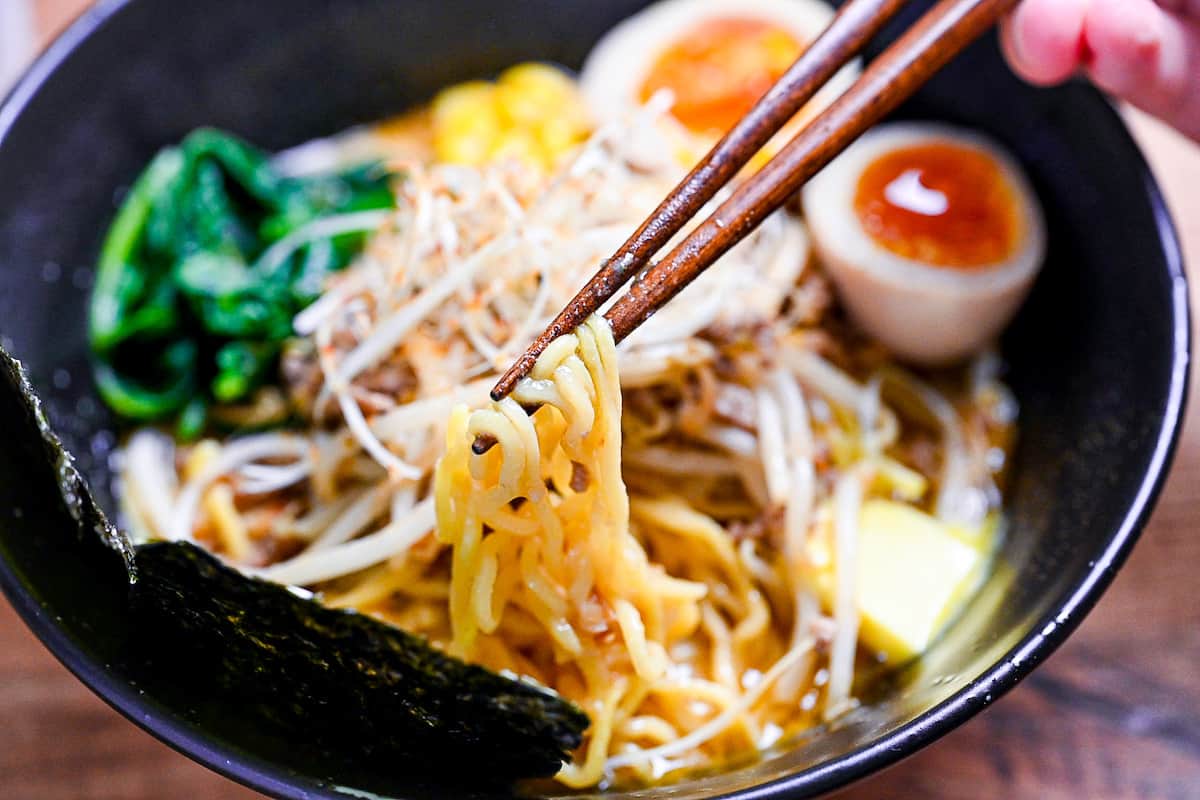
I hope you enjoy this Easy Pork Miso Ramen recipe! If you try it out, I’d really appreciate it if you could spare a moment to let me know what you thought by giving a review and star rating in the comments below. It’s also helpful to share any adjustments you made to the recipe with our other readers. Thank you!
More Ramen Recipes
- Chicken Shio Ramen (Salt Base)
- Classic Shoyu Ramen (Soy Sauce Base)
- Tantan Ramen (Spicy Chinese-style)
- Spicy Tsukemen (Dipping Ramen)
Want more inspiration? Explore my Ramen Recipe Roundup for a carefully selected collection of tasty recipe ideas to spark your next meal!

Pork Miso Ramen in 15 Minutes (Sapporo Style)
Equipment
- Noodle strainer
Ingredients
Pork
- 1 tsp unsalted butter
- 150 g ground pork
- 4 cloves garlic finely diced
- 1 tbsp ginger root finely diced
- 2 tbsp green onion white part, finely diced
- 1 tsp soy sauce
- 1 tsp mirin
- 1 tsp oyster sauce
- ½ tsp chili bean sauce tobanjan
Broth / Noodles
- 500 ml freshly boiled water
- 1 tsp Chinese-style chicken bouillon powder (granules)
- 1 tbsp smooth peanut butter
- 1 ½ tbsp yellow miso paste (awase miso)
- 2 portions ramen noodles
Toppings (Optional)
- 30 g spinach
- 100 g beansprouts
- 2 tsp sweet corn
- 2 tsp green onion green part, finely sliced
- 2 tsp unsalted butter
- 2 ramen egg or soft boiled egg
- 2 sushi nori seaweed nori
Instructions
- Melt 1 tsp unsalted butter in a pan over a medium heat and add 4 cloves garlic , 1 tbsp ginger root and 2 tbsp green onion. Once fragrant add 150 g ground pork and stir-fry until cooked through.

- Season with 1 tsp soy sauce, 1 tsp mirin, 1 tsp oyster sauce and ½ tsp chili bean sauce and mix thoroughly. Simmer until the liquid is almost gone and then turn off the heat.

- Take a heatproof measuring jug and whisk 500 ml freshly boiled water with 1 tsp Chinese-style chicken bouillon powder (granules) and 1 tbsp smooth peanut butter until dissolved. Pour the soup into the pan and heat on medium once more.

- Bring to a boil and then turn off the heat. Place 1 ½ tbsp yellow miso paste (awase miso) on a mesh spoon or ladle, dip it into the soup and then whisk it to break it up. This technique makes it easier to incorporate the miso into the soup smoothly without lumps. (Alternatively, mix the miso paste with a small amount of broth in a separate bowl and pour back into the pan once smooth.)

- Add 100 g beansprouts to the broth and cook them in the residual heat for 1-2 minutes. (No need to turn the heat back on.)

- Cook 2 portions ramen noodles according to the instructions on the packaging and add 30 g spinach to the water in the final minute. Drain using a colander and rinse both the noodles and spinach with fresh hot water to wash off any excess starch.

- Dish up the noodles into a large bowl, pour the broth over the noodles and top with the pork, beansprouts and spinach. Garnish with green onion (green part), sweet corn (straight from the tin is fine but you can microwave them if you prefer them warm.) and unsalted butter in each bowl.

- Enjoy!





Hi!
What kind of smooth peanut butter is it?
Can I buy the noodles online? I can’t find it here where I live. Thank you!
Hi Michele!
Thanks for your question! I personally used Skippy, but it’s fine to use other brands as long as it’s the smooth kind. Skippy is known for being a bit salty and having more of a “roasted” flavour so I recommend it!
You should be able to buy ramen noodles online (they have them on Amazon etc) but if you can’t get them, you could try out my “ramen noodles made with spaghetti hack” https://sudachirecipes.com/ramen-noodle-hack-recipe/
Hope that helps, happy cooking! 🙂
This ramen recipe was so good! It was easy to make, too. The miso got it close to tasting like my favorite local restaurant ramen. I’ll definitely be making it this way from now on.
Hi Misty,
Thank you for your comment! I’m happy to hear that you enjoyed this recipe! 🙂
Yuto